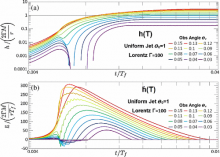
Abstract
While the possible roles of gamma ray bursts’ (GRBs) progenitors as gravitational waves (GW) sources have been extensively studied, little attention has been given to the GRB jet itself as a GW source. We expect the acceleration of the jet to produce a Gravitational Wave Memory signal. While all relativistic jet models display antibeaming of GW radiation away from the jet axis, thus radiating away from directions of GRBs’ γ radiation, this effect is not overwhelming. The decrease of the signal amplitude toward the cone of γ-ray detectability is weak, and for some models and parameters the GW signal reaches a significant amplitude for much of the γ-ray cone. Thus both signals may be jointly detected. We find different waveforms and Fourier signatures for uniform jets and structured jet models—thus offering a method of using GW signatures to probe the internal structure and acceleration of GRB jets. The GW signal peaks just outside the jet (core) of a uniform (structured) jet. Within the jet (core) the GW signal displays wiggles, due to a polarization effect; thus for a uniform jet, the peak amplitude accompanies a smoother signal than the peak of a structured jet. For the most probable detection angle and for typical GRB parameters, we expect frequencies ≲600 Hz and amplitudes h∼10−25. Our estimates of the expected signals suggest that the signals are not strong enough for a single cluster of DECIGO nor for aLIGO’s sensitivities. However, sensitivities of ∼10−25/√Hz in the DECIGO band should suffice to detect typical long GRBs at 2 Gpc and short GRBs at 200 Mpc, implying a monthly event of a long GRB and a detection of a short GRB every decade. In addition, we expect much more frequent detection of GW from GRBs directed away from us, including orphan afterglows. The ultimate DECIGO sensitivy should increase the range and enable detecting these signals in all models even to high cosmological z.